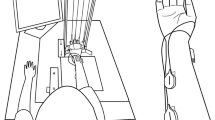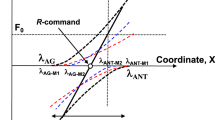Abstract
The concept of synergies has been used to address the grouping of motor elements contributing to a task with the covariation of these elements reflecting task stability. This concept has recently been extended to groups of motor units with parallel scaling of the firing frequencies with possible contributions of intermittent recruitment (MU-modes) in compartmentalized flexor and extensor muscles of the forearm stabilizing force magnitude in finger pressing tasks. Here, we directly test for the presence and behavior of MU-modes in the tibialis anterior, a non-compartmentalized muscle. Ten participants performed an isometric cyclical dorsiflexion force production task at 1 Hz between 20 and 40% of maximal voluntary contraction and electromyographic (EMG) data were collected from two high-density wireless sensors placed on the skin over the right tibialis anterior. EMG data were decomposed into individual motor unit frequencies and resolved into sets of MU-modes. Inter-cycle analysis of MU-mode magnitudes within the framework of the uncontrolled manifold (UCM) hypothesis was used to quantify force-stabilizing synergies. Two or three MU-modes were identified in all participants and trials accounting, on average, for 69% of variance and were robust to cross-validation measurements. Strong dorsiflexion force-stabilizing synergies in the space of MU-modes were present in all participants and for both electrode locations as reflected in variance within the UCM (median 954, IQR 511–1924) exceeding variance orthogonal to the UCM (median 5.82, IQR 2.9–17.4) by two orders of magnitude. In contrast, MU-mode-stabilizing synergies in the space of motor unit frequencies were not present. This study offers strong evidence for the existence of synergic control mechanisms at the level of motor units independent of muscle compartmentalization, likely organized within spinal cord circuitry.







Similar content being viewed by others
Data availability
Data are available by reasonable request to the corresponding author.
References
Aarabi A, Grebe R, Wallois F (2007) A multistage knowledge-based system for EEG seizure detection in newborn infants. Clin Neurophysiol 118:2781–2797
Bernstein NA (1947) On the construction of movements. Medgiz, Moscow (in Russian. English translation in Latash 2020a)
Bowler RM, Nakagawa S, Drezgic M, Roels HA, Park RM, Diamond E (2007) Sequelae of fume exposure in confined space welding: a neurological and neuropsychological case series. Neurotoxicol 28:298–311
Cersosimo MG, Koller WC (2006) The diagnosis of manganese-induced parkinsonism. Neurotoxicol 27:340–346
Cohen JW, Vieira TM, Ivanova TD, Garland SJ (2023) Differential behavior of distinct motoneurona pools that innervate the triceps surae. J Neurophysiol 129:272–284
Contessa P, DeLuca CJ (2013) Neural control of muscle force: indications from a simulation model. J Neurophysiol 109:1548–1570
Danion F, Latash ML, Li S (2003) Finger interactions studied with transcranial magnetic stimulation during multi-finger force production tasks. Clin Neurophysiol 114:1445–1455
Danna-Dos-Santos A, Slomka K, Zatsiorsky VM, Latash ML (2007) Muscle modes and synergies during voluntary body sway. Exp Brain Res 179:533–550
De Freitas PB, Freitas SMSF, Reschechtko S, Corson T, Lewis MM, Huang X, Latash ML (2020a) Synergic control of action in levodopa-naïve Parkinson’s disease patients: I. Multi-finger interaction and coordination. Exp Brain Res 238:229–245
De Luca CJ, Chang S-S, Roy SH, Kline JC, Nawab SH (2015) Decomposition of surface EMG signals from cyclic dynamic contractions. J Neurophysiol 113:1941–1951
Del Vecchio A, Holobar A, Falla D, Felici F, Enoka RM, Farina D (2020) Tutotial: Analysis of motor unit discharge characteristics from high-density surface EMG signals. J Electromyogr Kinesiol 53:102426
Enoka RM, Robinson GA, Kossev AR (1989) Task and fatigue effects on low-threshold motor units in human hand muscle. J Neurophysiol 62:1344–1359
Farina D, Enoka RM (2011) Surface EMG decomposition requires an appropriate validation. J Neurophysiol 105:981–982
Feldman AG (1966) Functional tuning of the nervous system with control of movement or maintenance of a steady posture. II. Controllable Parameters of the Muscle. Biophysics 11:565–578
Feldman AG (1986) Once more on the equilibrium-point hypothesis (λ–model) for motor control. J Mot Behav 18:17–54
Feldman AG (2015) Referent control of action and perception: Challenging conventional theories in behavioral science. Springer, NY
Freitas SMSF, Scholz JP, Latash ML (2010) Analyses of joint variance related to voluntary whole-body movements performed in standing. J Neurosci Methods 188:89–96
Freitas SMSF, de Freitas PB, Lewis MM, Huang X, Latash ML (2019) Quantitative analysis of multi-element synergies stabilizing performance: Comparison of three methods with respect to their use in clinical studies. Exp Brain Res 237:453–465
Freitas SMSF, de Freitas PB, Falaki A, Corson T, Lewis MM, Huang X, Latash ML (2020b) Synergic control of action in levodopa-naïve Parkinson’s disease patients. II. Multi-muscle synergies stabilizing vertical posture. Exp Brain Res 238:2931–2945
Fuglevand AJ, Dutoit AP, Johns RK, Keen DA (2006) Evaluation of plateau-potential-mediated “warm up” in human motor units. J Physiol 571:683–693
Fuglevand AJ, Lester RA, Johns RK (2015) Distinguishing intrinsic from extrinsic factors underlying firing rate saturation in human motor units. J Neurophysiol 113:1310–1322
Gorniak S, Zatsiorsky VM, Latash ML (2007) Hierarchies of synergies: An example of the two-hand, multi-finger tasks. Exp Brain Res 179:167–180
Gorniak S, Zatsiorsky VM, Latash ML (2009) Hierarchical control of static prehension: II Multi-Digit Synergies. Exp Brain Res 194:1–15
Hug F, Avrillon S, Ibanez J, Farina D (2023) Common synaptic input, synergies and size principle: control of spinal motor neurons for movement generation. J Physiol 601:11–20
Ivanenko YP, Poppele RE, Lacquaniti F (2006) Motor control programs and walking. Neuroscientist 12:339–348
Jeneson JA, Taylor JS, Vigneron DB, Willard TS, Carvajal L, Nelson SJ, Murphy-Boesch J, Brown TR (1990) 1H MR imaging of anatomical compartments within the finger flexor muscles of the human forearm. Magn Res Med 15:491–496
Jo HJ, Park J, Lewis MM, Huang X, Latash ML (2015) Prehension synergies and hand function in early-stage Parkinson’s disease. Exp Brain Res 233:425–440
Jolliffe IT (1982) A note on the use of principal components in regression. J Royal Stat Soc Ser C (appl Stat) 31:300–303
Kim EH, Wilson JM, Thompson CK, Heckman CJ (2020) Differences in estimated persistent inward currents between ankle flexors and extensors in humans. J Neurophysiol 124:525–535
Krishnamoorthy V, Latash ML, Scholz JP, Zatsiorsky VM (2003) Muscle synergies during shifts of the center of pressure by standing persons. Exp Brain Res 152:281–292
Krishnamoorthy V, Scholz JP, Latash ML (2007) The use of flexible arm muscle synergies to perform an isometric stabilization task. Clin Neurophysiol 118:525–537
Kundu M, Nasipuri M, Kumar Basu D (2000) Knowledge-based ECG interpretation: a critical review. Pattern Recogn 33:351–373
Latash ML (2010) Motor synergies and the equilibrium-point hypothesis. Mot Control 14:294–322
Latash ML (2019) Physics of biological action and perception. Academic Press, New York, NY
Latash ML (ed) (2020a). Routledge, Abingdon, UK
Latash ML (2020b) On primitives in motor control. Mot Control 24:318–346
Latash ML (2021) One more time about motor (and non-motor) synergies. Exp Brain Res 239:2951–2967
Latash ML, Li Z-M, Zatsiorsky VM (1998) A principle of error compensation studied within a task of force production by a redundant set of fingers. Exp Brain Res 122:131–138
Latash ML, Scholz JF, Danion F, Schöner G (2001) Structure of motor variability in marginally redundant multi-finger force production tasks. Exp Brain Res 141:153–165
Latash ML, Scholz JP, Schöner G (2007) Toward a new theory of motor synergies. Mot Control 11:276–308
Latash ML, Madarshahian S, Ricotta J (2023) Intra-muscle synergies: their place in the neural control hierarchy. Mot Control. https://doi.org/10.1123/mc.2022-0094. (in press)
Levin MF, Dimov M (1997) Spatial zones for muscle coactivation and the control of postural stability. Brain Res 757:43–59
Lewis MM, Lee E-Y, Jo HJ, Park J, Latash ML, Huang X (2016) Synergy as a new and sensitive marker of basal ganglia dysfunction: a study of asymptomatic welders. Neurotoxicol 56:76–85
Lulic-Kuryllo T, Inglis JG (2022) Sex differences in motor unit behaviour: A review. J Electromyogr Kinesiol 66:102689
Madarshahian S, Latash ML (2021) Synergies at the level of motor units in single-finger and multi-finger tasks. Exp Brain Res 239:2905–2923
Madarshahian S, Latash ML (2022a) Reciprocal and coactivation commands at the level of individual motor units in an extrinsic finger flexor-extensor muscle pair. Exp Brain Res 240:321–340
Madarshahian S, Latash ML (2022b) Effects of hand muscle function and dominance on intra-muscle synergies. Hum Move Sci 82:102936
Madarshahian S, Letizi J, Latash ML (2021) Synergic control of a single muscle: the example of flexor digitorum superficialis. J Physiol 599:1261–1279
Madarshahian S, Ricotta J, Latash ML (2022) Intra-muscle synergies stabilizing reflex-mediated force changes. Neurosci 505:59–77
Mariappan YK, Manduca A, Glaser KJ, Chen J, Amrami KK, Ehman RL (2010) Vibration imaging for localization of functional compartments of the extrinsic flexor muscles of the hand. J Magn Res Imag 31:1395–1401
Mesin L, Merlo E, Merletti R, Orizio C (2010) Investigation of motor unit recruitment during stimulated contractions of tibialis anterior muscle. J Electromyogr Kinesiol 20:580–589
Nawab SH, Chang S-S, De Luca CJ (2010) High-yield decomposition of surface EMG signals. Clin Neurophysiol 121:1602–1615
Oya T, Riek S, Cresswell AG (2009) Recruitment and rate coding organisation for soleus motor units across entire range of voluntary isometric plantar flexions. J Physiol 589:4737–4748
Park J, Wu Y-H, Lewis MM, Huang X, Latash ML (2012) Changes in multi-finger interaction and coordination in Parkinson’s disease. J Neurophysiol 108:915–924
Santello M, Bianchi M, Gabiccini M, Ricciardi E, Salvietti G, Prattichizzo D, Ernst M, Moscatelli A, Jorntell H, Kappers AM, Kyriakopoulos K, Schaeffer AA, Castellini C, Bicchi A (2016) Hand synergies: Integration of robotics and neuroscience for understanding the control of biological and artificial hands. Phys Life Rev 17:1–23
Scholz JP, Schöner G (1999) The uncontrolled manifold concept: Identifying control variables for a functional task. Exp Brain Res 126:289–306
Scholz JP, Schöner G, Latash ML (2000) Identifying the control structure of multijoint coordination during pistol shooting. Exp Brain Res 135:382–404
Scholz JP, Danion F, Latash ML, Schöner G (2002) Understanding finger coordination through analysis of the structure of force variability. Biol Cybern 86:29–39
Schöner G (1995) Recent developments and problems in human movement science and their conceptual implications. Ecol Psychol 8:291–314
Tanzarella S, Muceli S, Santello M, Farina D (2021) Synergistic organization of neural inputs from spinal motor neurons to extrinsic and intrinsic hand muscles. J Neurosci 41:6878–6891
Ting LH, McKay JL (2007) Neuromechanics of muscle synergies for posture and movement. Curr Opin Neurobiol 17:622–628
Tresch MC, Cheung VC, d’Avella A (2006) Matrix factorization algorithms for the identification of muscle synergies: evaluation on simulated and experimental data sets. J Neurophysiol 95:2199–2212
Yavuz US, Negro F, Diedrichs R, Farina D (2018) Reciprocal inhibition between motor neurons of the tibialis anterior and triceps surae in humans. J Neurophysiol 119:1699–1706
Zero AM, Kirk EA, Rice CL (2020) Firing rate trajectories of human motor units during activity-dependent muscle potentiation. J Appl Physiol 132:402–412
Acknowledgements
We are grateful to Dr. Matteo Bertucco for contributing necessary equipment and expertise for data collection. We are also very much grateful to Delsys, Inc. for providing the Trigno system and associated software on free loan.
Author information
Authors and Affiliations
Corresponding author
Ethics declarations
Conflict of interest
The authors have no relevant financial or non-financial interests to declare.
Additional information
Communicated by Bill J Yates.
Publisher's Note
Springer Nature remains neutral with regard to jurisdictional claims in published maps and institutional affiliations.
Rights and permissions
Springer Nature or its licensor (e.g. a society or other partner) holds exclusive rights to this article under a publishing agreement with the author(s) or other rightsholder(s); author self-archiving of the accepted manuscript version of this article is solely governed by the terms of such publishing agreement and applicable law.
About this article
Cite this article
Ricotta, J.M., Nardon, M., De, S.D. et al. Motor unit-based synergies in a non-compartmentalized muscle. Exp Brain Res 241, 1367–1379 (2023). https://doi.org/10.1007/s00221-023-06606-9
Received:
Accepted:
Published:
Issue Date:
DOI: https://doi.org/10.1007/s00221-023-06606-9




